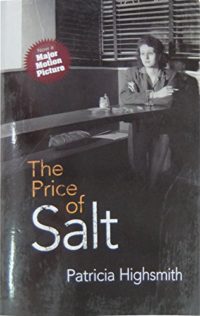There was not a moment when she did not see Carol in her mind
 The Price of Salt
The Price of Salt
by Patricia Highsmith
Way back in the mists of time – 2005, maybe? – I read The Talented Mr Ripley by Patricia Highsmith for an old book club. I enjoyed it but wasn’t bowled over, so for a long time felt no urgency to try Highsmith again. This is despite one of my favourite films – Strangers on a Train – being based on a Highsmith book, not to mention regular mentions of her work by book bloggers whose taste I often share.
Finally, when the film Carol came out in 2015, based on this novel, the sudden rush of reviews of The Price of Salt persuaded me to give it a go. And I am so glad that I did. I loved this unreservedly and am eagerly adding more Highsmith novels to my wishlist now.
The story is told from the perspective of Therese, a young woman who, when the novel opens, is working in a New York City department store as a temporary Christmas job, though her ambition is to be a set designer. She sees Richard most days – an art student who she thinks of as her best friend and who thinks of her as his future wife. But that disparity doesn’t matter until the day Carol comes into the store. In their brief interaction, Therese is so bowled over that she immediately finds a way to get in touch with Carol, to instigate another meeting.
“But there was not a moment when she did not see Carol in her mind, and all she saw, she seemed to see through Carol. That evening, the dark flat streets of New York, the tomorrow of work, the milk bottle dropped and broken in her sink, became unimportant. She flung herself on her bed and drew a line with a pencil on a piece of paper. And another line, carefully, and another. A world was born around her, like a bright forest with a million shimmering leaves.”
They are not an obvious pairing. Therese is 20, effectively an orphan supporting herself, living in Manhattan, friends with theatrical and artistic people, none of whom she has known for long as she has tried to cut links to her past. Carol is in her early 30s, a rich suburban housewife with a daughter and an elegant wardrobe. She has a housekeeper and a best friend she has known since they were small children.
The attraction is clearly mutual, though it is less obvious whether both parties feel it equally, or whether they are ready and willing to act on it. Carol is already in the midst of divorce. Therese risks losing Richard’s friendship but that day was approaching anyway. For her, the shock is the discovery of being in love for the first time, and secondary to that, its being with a woman. Carol exudes cool and shows no sign of being perturbed by Therese’s obvious adoration, but she also doesn’t show whether she returns it or simply enjoys Therese’s company.
“January. It was all things. And it was one thing, like a solid door. Its cold sealed the city in a grey capsule. January was moments, and January was a year. January rained the moments down, and froze them in her memory… Every human action seemed to yield a magic. January was a two-faced month, jangling like jester’s bells, crackling like snow crust, pure as any beginning, grim as an old man, mysteriously familiar, yet unknown, like a word one can almost but not quite define.”
For Therese, this is a coming-of-age story – first love, first road trip across America, first steps in her career, first inkling of which of her friends will remain friends. For Carol, this is a thriller – her husband is trying to get sole custody of their daughter and one mis-step from her could mean never seeing her child again. And the final third of this novel does read like a thriller, drawing on what Highsmith did so well in her other writings.
It’s worth remembering that this was written in the 1950s and at that time in many US states female homosexuality was not just socially not accepted, but actually illegal (rather than only male homosexual acts being illegal, as in the UK at the time). All affection – even a gesture or a look of love – must happen behind closed doors. Some people in their lives accept their relationship and some don’t. (Sadly the women’s story does not feel so very dated. The law may have modernised in pretty much all the Western world, but social attitudes still lag behind.)
“Was life, were human relations like this always, Therese wondered. Never solid ground underfoot. Always like gravel, a little yielding, noisy so the whole world could hear, so one always listened, too, for the loud, harsh step of the intruder’s foot.”
Therese fairly quickly accepts that she is in love with a woman. She doesn’t then worry or self-examine about whether she is a lesbian but she does take offence when a friend calls it unnatural, because to her it is entirely natural. Is this the adaptability, maybe even the naivety, of youth? She does, briefly, note that she and Carol do not look like lesbians (by which I think we are meant to infer butch or at least tomboyish, though she doesn’t explain fully). She simply experiences the usual traumas of first love. Is it requited? Will it last?
But more even than the storyline that treads a careful line between reality and Hollywood sparkle, between gentle romance and thrilling adventure, I loved Highsmith’s writing. I marked dozens of quotes. And I will certainly return to this book. Definitely.
Published 1952 by Coward-McCann under the pseudonym Claire Morgan. Republished in 1990 as Carol by Patricia Highsmith.
Source: Present from my Dad.
Challenges: This counts towards the Classics Club.